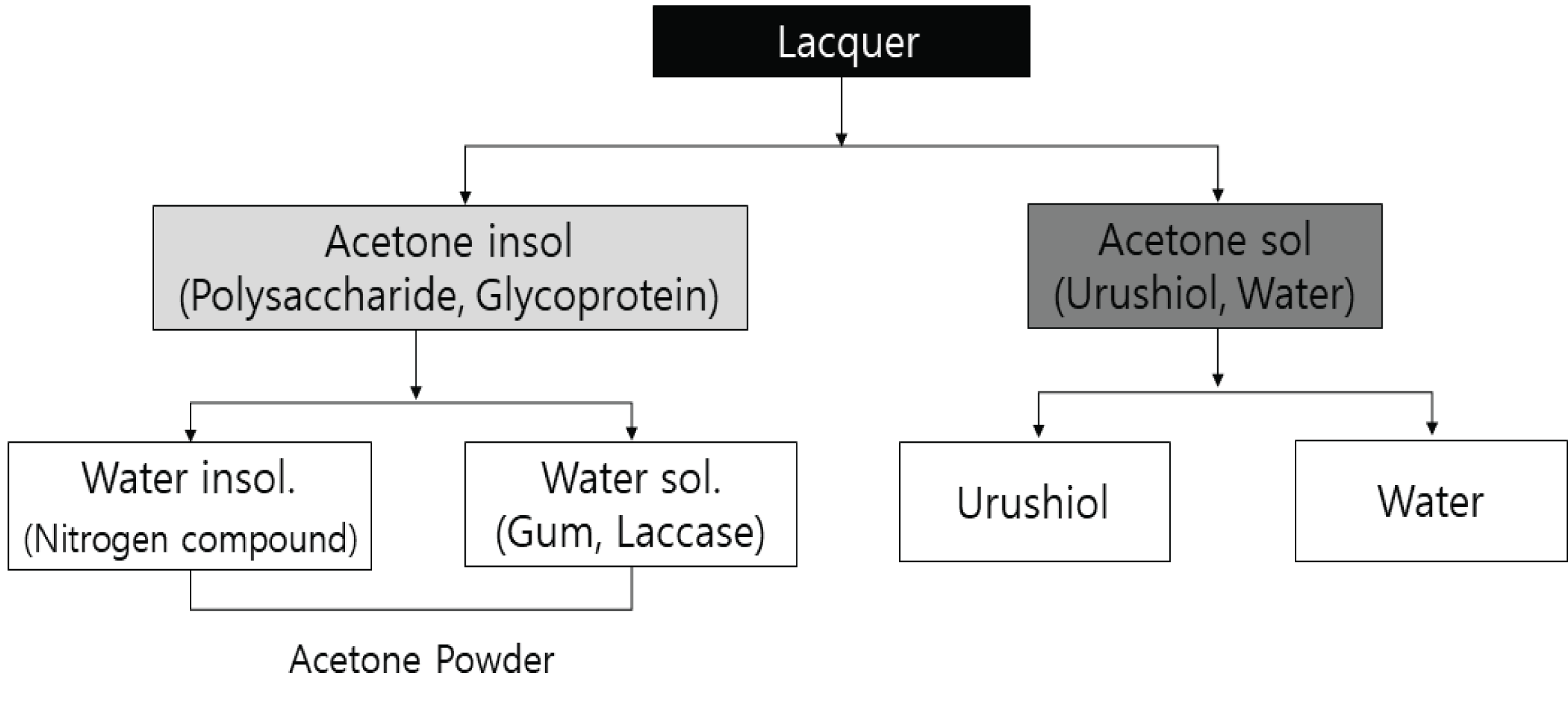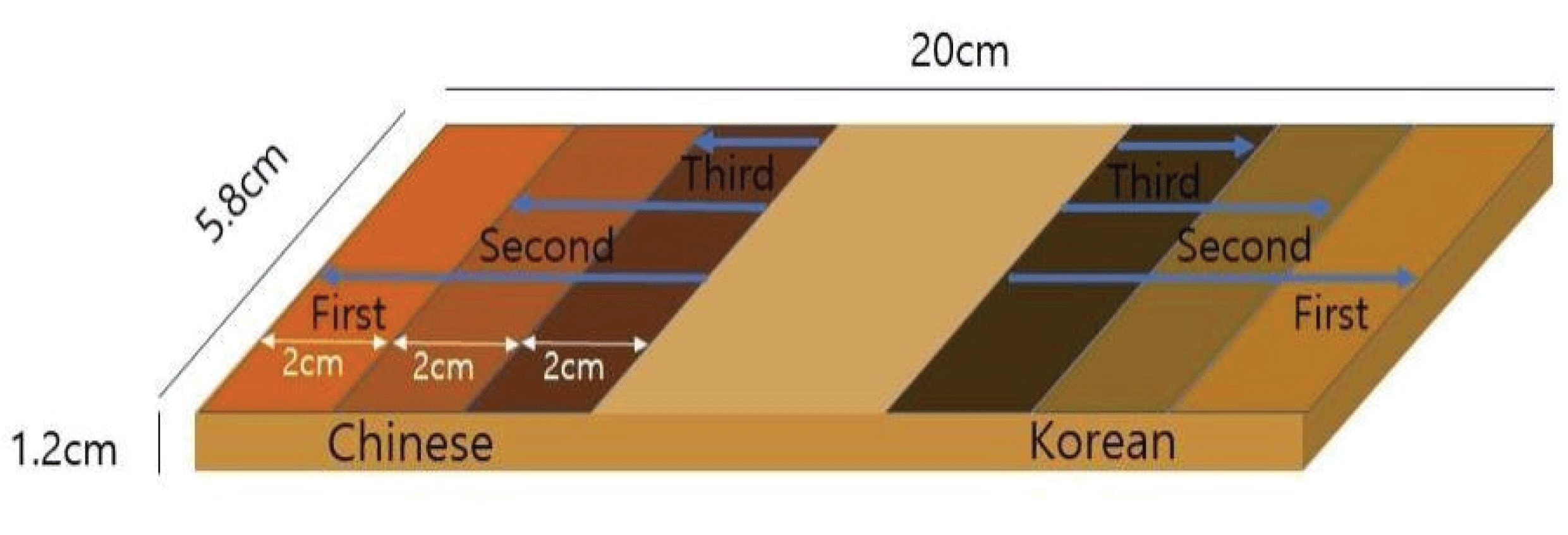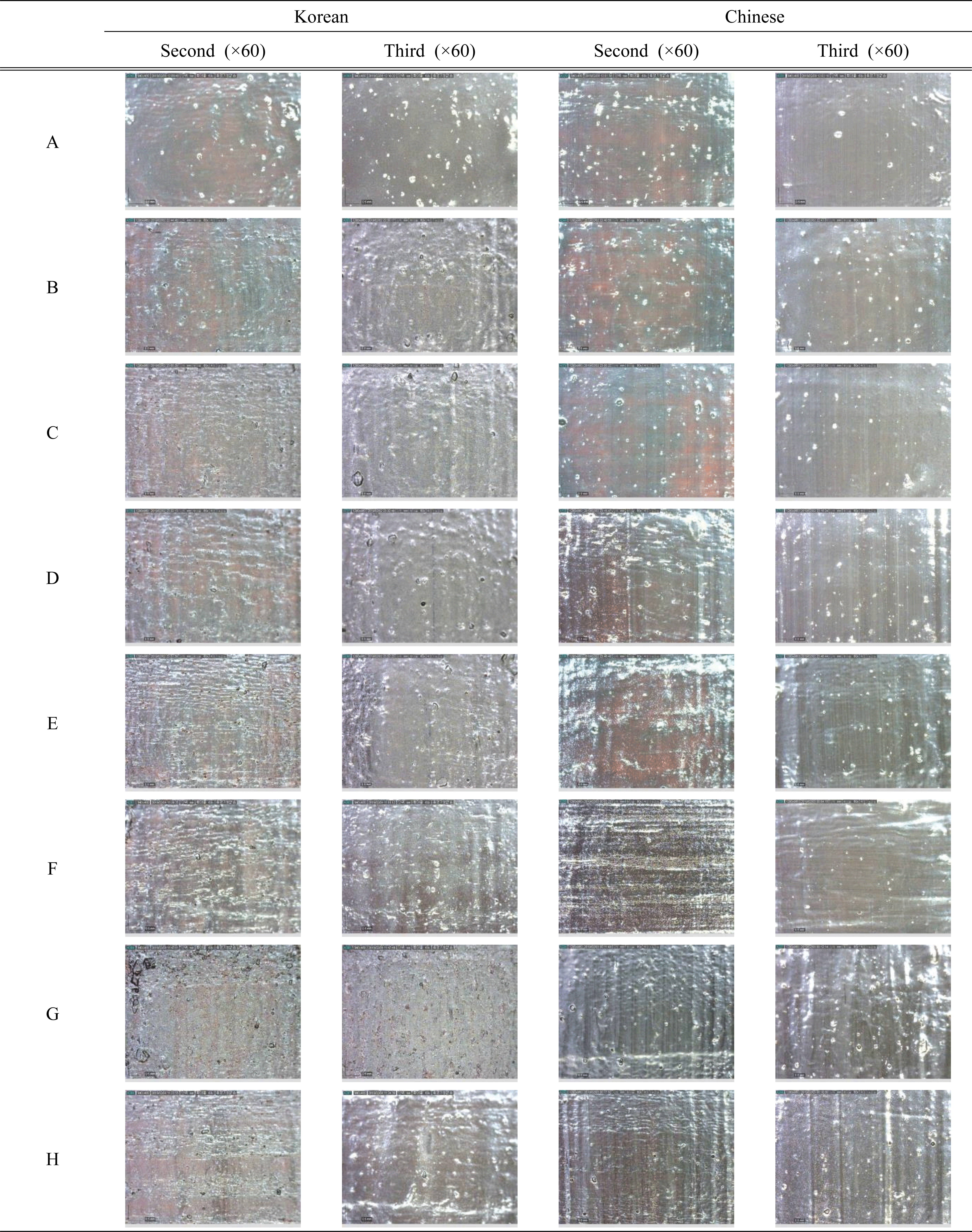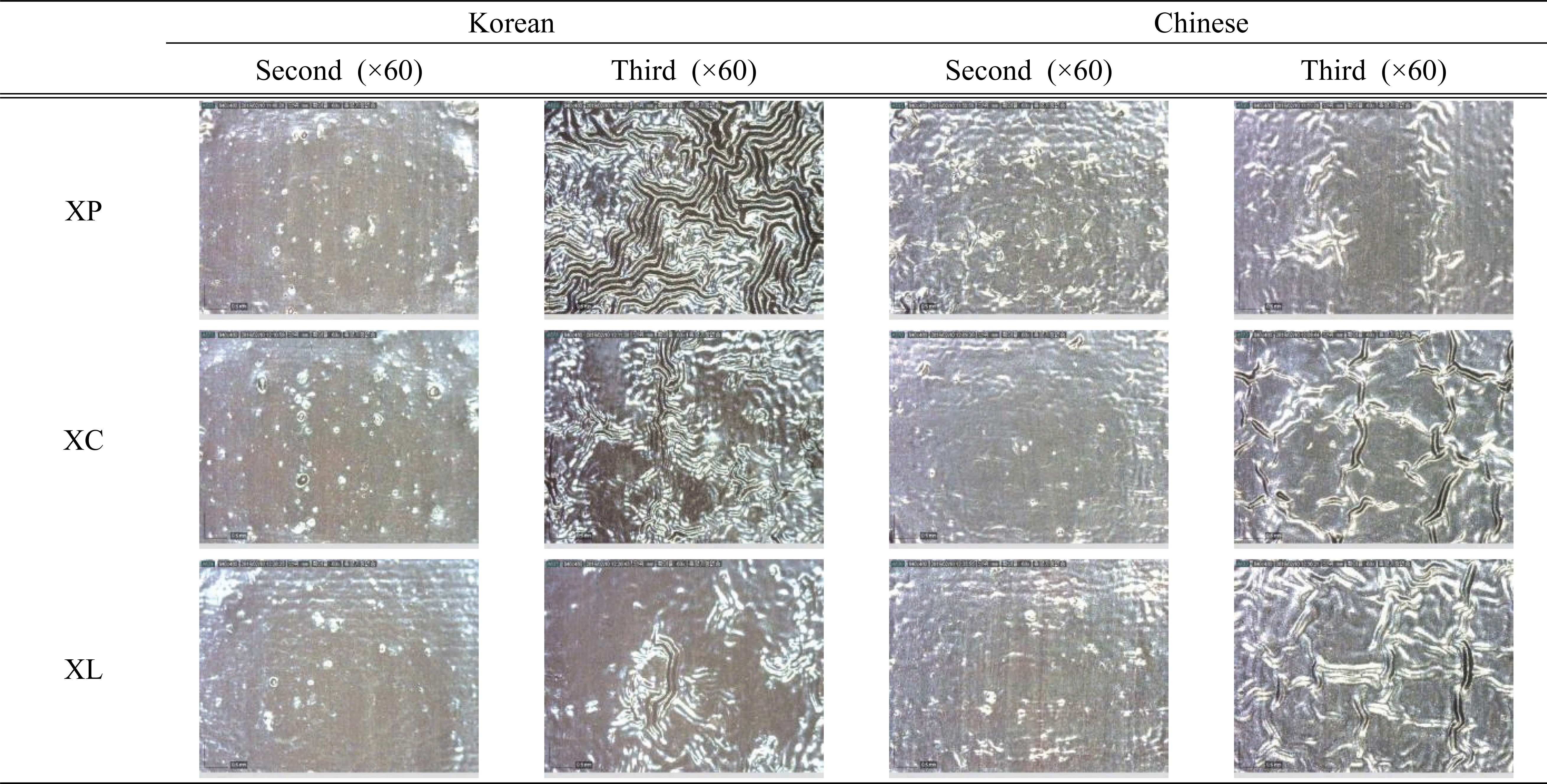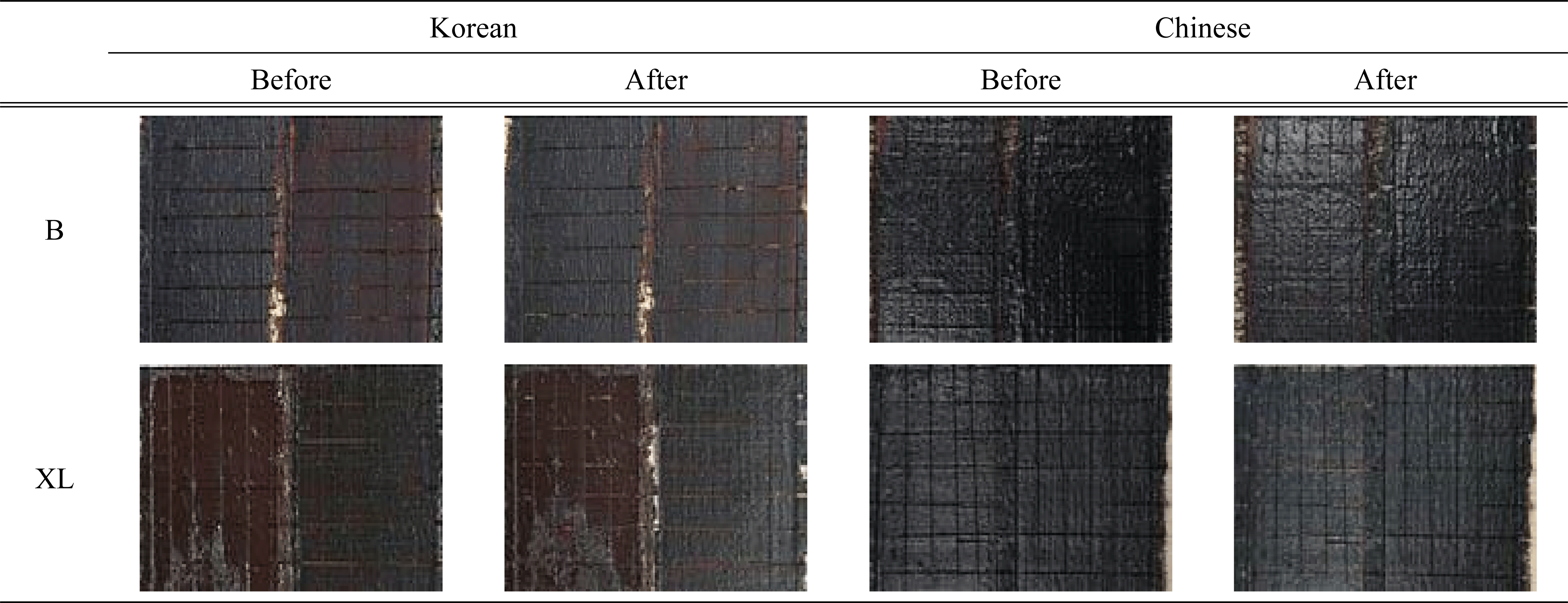1. INTRODUCTION
Lacquer has been widely used as a paint for wood products since it is durable, waterproof and moisture- proof. Although it is not clear exactly when the lacquer was started to be used in Korea, it seems that lacquer culture has been around since ancient times since various lacquerware artifacts have been excavated from the ruins of Namseong-ri, Asan, Chungnam, Sinchang-dong, Gwangju, Daho-ri, Changwon and Muryeong Royal Tombs, Gongju (Lee, 2010). As the lacquer culture has been succeeded and developed since ancient times, various materials and manufacturing techniques were used. And the lacquerware cultural properties which were produced as such well indicate the life and culture from that era (Kim, 2007).
The conservation of cultural properties relies on the conservation of their prototypes in principle, and the restoration materials shall also be the same with those used for the original properties (Lee, 2017). Thus, a natural material of lacquer shall be used for the conservation of the lacqeurware cultural properties. However, since the ratio of materials in lacquer collected from the lacquer tree varies depending on manufacturing locations, harvesting times, and processing methods (Song and Han, 2001), there are differences in quality and drying patterns of lacquer, and drying conditions are complicated. Therefore, it has a limitation in conserving lacqeurware cultural properties.
Lacquer is a natural material that forms threedimensional polymers via urushiol oxidation, consisting of urushiol, moisture, rubber, nitrogenous materials and enzymes (Do and Lee, 1999). As the main component of lacquer, urushiol gets hardened and dried when contacted by oxygen, forming layers (Park and Ahn, 2018). Since the activation of enzymes occurs only under the presence of moisture, high humidity conditions are needed for drying lacquer (Shin, 2008). In addition, since enzyme is also not activated at a temperature above 50 °C, a lower temperature condition is required. Various materials used for lacquerware such as wood, metal, and leather, could cause secondary damages when exposed to high humidity conditions for hardening and drying lacquer, limiting the accessibility of using lacquer for the conservation.
Therefore, this study aims to apply laccase as an enzyme additive, supplements the differences in composition by region and improves the drying speed in order to enhance the accessibility of using the natural material of lacquer. In addition, it also aims to investigate the stability of additives through the analysis of lacquer layers, so that it could be used in conserving the lacquerware cultural properties.
2. MATERIALS and METHODS
Korean and Chinese unrefined lacquers were used to compare the ratio of components of lacquer by region. The unrefined lacquer refers to a lacquer whose impurities were removed without going through a refinement process after collecting lacquer from a part of a lacquer tree by scratching it with a scythe (Son, 2006). Korean unrefined lacquer was manufactured in Wonju, and Chinese unrefined lacquer was purchased from the market.
In this study, specimens for lacquer were produced by using pine trees which are relatively easy to obtain and process. Wooden boards having the dimension of 5.8 cm × 20 cm × 1.2 cm were cut out, and those without knots or defects were selected and used as specimens.
The strains were cultured and refined by obtained from korean mushroom resource bank(KMRB) for pleurotus ostreatus, coriolus versicolor, and lentinula edodes, among the white-rot fungi that secrete laccase enzyme (Jung, 2019). The strains were inoculated into Potato dextrose agar slant, incubated at 22 °C, stored at 4 °C, and subcultured in PDA medium every 4 weeks (Park et al., 1993). For the liquid medium for enzyme refinement, 20 g of malt extract, 5 g of yeast extract, 10 g of dextrose, and 5 g of peptone at pH 5.5 per liter were used (Jeong et al., 1992). (Table 1).
| Lacquer | Urushiol | Water | Nitrogenated material | Gum and Laccase |
|---|---|---|---|---|
| Korean | 72% | 20% | 1% | 7% |
| Chinese | 55% | 16% | 7% | 22% |
To apply the laccase as an additive, it was refined in lacquer and white-rot fungi. The lacquer was separated into its main components, urushiol, water, glycoprotein, rubber, and enzyme, using acetone and water in accordance with the lacquer separation method suggested by ‘Standardization, Diversification and Mass Production Process Development of Traditional Lacquer’ (Han, 2013).
After unrefined lacquers by region were dissolved in acetone and centrifuged, the supernatant separation process was repeated 3 to 4 times. Then only urushiol was refined, and the acetone was evaporated. After urushiol is separated, the remaining acetone powder is dried by a filter paper. The dried acetone powder is then dissolved in distilled water to filter out insoluble nitrogen content. Then, the soluble rubber content and laccase content were separated, concentrated and stored in a refrigerator.
Three types of strains sub-cultured in PDA medium every 4 weeks were inoculated into the liquid medium and shake-cultured in a 25 °C incubator (Kim et al., 1987). After 7 days of the shake-culturing, it was put in the filtrate, from which the mycelium was removed with a filter paper, to put 80% ammonium sulfate and then it was centrifuged for 20 minutes at 4 °C and 12,000 × g. The precipitate of the centrifuged filtrate was dissolved in a 0.02M phosphate buffer solution, dialyzed with the same buffer solution for 24 hours, and vacuum freeze-drying was performed (Won et al., 2004). (Fig. 1).
The proportion of the enzyme to urushiol was adjusted, and specimens were produced by adding laccase of lacquer into the unrefined lacquers by region. At the same time, in order to examine the possibility of applying laccase of white-rot fungi, it was applied using the most suitable content ratio among the results of applying laccase to lacquer (Table 2).
| Samples | Proportion (Urushiol : Laccase) | Samples | Fungi |
|---|---|---|---|
| A | Original | XP | Pleurotus |
| B | 5 : 1 | ostreatus | |
| C | 4.5 : 1 | XC | Coriolus |
| D | 4 : 1 | versicolor | |
| E | 3.5 : 1 | XL | Lentinula |
| F | 3 : 1 | edodes | |
| G | 2.5 : 1 | - | - |
| H | 2 : 1 |
For lacquering, the concentration is adjusted by using volatile terepine oil as a diluent for ease of painting (Hwang, 2018). In order to assimilate the work with the actual working conditions, application was done with 10:1 ratio between lacquer specimen and terpene oil. Korean and Chinese lacquer added by laccase of lacquer and white-rot fungi was applied to wood specimens 3 times in the order of initial (Chochil), medium (Jungchil), and last coating (Sangchil) according to region. Then, the samples were put into a drying room and dried (Fig. 2).
The lacquer specimens produced by adjusting proportion of laccase to urushiol were dried under conditions with temperature of 25 ± 1°C and humidity of 85-90% in a drying room. The drying patterns of lacquer specimens by region were observed every 30 minutes with respect to the content ratio of the enzyme to urushiol and number of applications, and the time at which hardening drying of the lacquer completed was measured. In addition, the specimens prepared in the same way were exposed to a room with temperature of 20 ± 2°C and humidity of 55-60% to confirm the possibility of drying at room temperature condition.
To identify the status of dry condition, set-to touch drying and hardening drying were first confirmed in accordance with 'Test Method 2511 for Drying Time of Application (varnish, lacquer, enamel and water- based paints)' among the 'Test Methods for KS M 5000 Paints and Related Raw Materials', followed by measuring the drying time.
Chromaticity and gloss were measured 3 times repeatedly on the specimen surface for each condition by using a spectrophotometer (CR-400, KONICA MINOLTA) and a spectrophotometer (A-6800, BYK). The chromaticity measurement values are L*, a*, b* values, and the gloss as a G values.
Based on the L*, a*, and b* values of the original lacquer (A), and using Eq. (1), the measured values for each specimen were substituted in L'*, a'*, and b'* to obtain the chromaticity difference value (ΔE*) (Hidayat et al., 2017). In general, the chromaticity differences below ΔE 3 are not recognized, and those below ΔE 6 are assumed to have the same chromaticity.
L* : Degree of lightness (white 100 ~ 0 dark)
a* : Degree of redness (red +50 ~ -50 green)
b* : Degree of yellowness (yellow +50 ~ -50 blue)
In order to examine the drying patterns of the lacquer surface following the enzyme addition, the dried lacquer specimens surface were observed with a portable microscope (Lite plus AM313, DINO). The specimen surface was observed at a 60x magnification, and the surfaces of the medium layers and last layers among the dried lacquer specimens were photographed.
From the dried lacquer specimens, sections of the three times coatings were collected to prepare thin slices. After placing the slices on a slide glass, 50% glycerin aqueous solution was dropped, and the slices were covered with a cover glass to produce microscopic observations. The cross sections of the layers on the preparat was observed by using an optical microscope (Eclipse Lv 100, Nikon, Japan) (Kim et al., 2010).
The adhesion of the dried specimens were evaluated by using ‘KS M ISO 2409, paint and varnish-paint adhesion test method’. Using a scalpel, 6 horizontal lines and 4 vertical lines were cut in a grid pattern on the specimens to make 30 scales with a 5 mm gap. First, a transparent adhesive tape was attached on the specimen with the grid formed, and peeled off to allow for the calculation of the separated area (Roh and Kim, 2008). The adhesion was evaluated on the twice and three times coated lacquer layers.
Infrared spectroscopy analysis was carried out to observe the changes in the composition of lacquer by each region following the laccase addition. The infrared spectroscopy analysis was performed by using the Cary620 Microscope (Agilent, USA) FT-IR equipment on the specimens that were prepared by drying only lacquer on a glass plate (Kim, 2016). With the analysis condition set to ATR mode, scanning was performed 32 times repeatedly at the resolution of 4 cm-1 and measurement range of 400 to 4,000 cm-1 (Lee and Kim, 1990).
The pyrolysis gas chromatography mass spectrometry was performed to confirm the changes in lacquer composition based on adding the laccase. Using a pyrolysis device (Py-3030D, Frontier Lab, JPN), the dried only lacquer specimen was injected into its inlet without pretreatment and analyzed. 250 °C was set as the inlet temperature, and 600 °C as the pyrolytic temperature.
The analysis was performed with a DB-5ms column (Agilent, USA) by using a gas chromatography/mass spectrometer (6890A, Agilent, USA / 5975C, Agilent, USA). The temperature of the oven was set to maintain at 40 °C for 5 minutes, and to increase at a rate of 20 °C per minute up to 300 °C, and maintain the temperature for 10 minutes for the analysis. In split mode, helium was used as the gas at the mobile phase with the flow rate of 1.0 mL/min. The ion source of the mass spectrometer was EI 70eV (Choi and Kim, 2018).
3. RESULTS and DISCUSSION
In the case of applying laccase of lacquer and whiterot fungi, drying time was shorter than in a case of not applying the laccase to lacquer in both Korean and Chinese specimens. In addition, all the specimens to which laccase was applied were dried (set to touch) within the 60 minutes from the start of the drying, and the drying speed was improved with the increase in the content ratio of laccase (Table 4).
As a result of applying laccase of the lacquer, it was confirmed that the drying rate was improved and no changes in the surface was observed with the naked eyes when the proportion of laccase to urushiol was 5:1. Therefore, the proportion of laccase to urushiol at 5:1 was judged to be the most stable condition. Then, the laccase of the refined white-rot fungi was applied with the same ratio and tested.
When laccase of the white-rot fungi was applied, it was found that drying time of initial coating was reduced only for the Korean specimens, and drying rate of the Chinese specimens were slowed down than that of the Original lacquer. In the case of medium and last coatings, drying speed was improved in a pattern similar to that of the specimen with the laccase of the lacquer applied regardless of the regions.
The results of the room temperature condition drying experiment showed that although there was a difference in hardening drying time between the Korean and Chinese spceimens, it was confirmed that hardening drying performed even in the room with temperature of 20 ± 2 °C and humidity of 55-60% (Table 3). In contrast to original lacquer not dried in room temperature condition, when laccase added as an additive, drying rate not only improved but also expected to improve the drying conditions requiring high humidity.
| Sample | Number of times | Type of lacquer | Hardening drying time (min) |
|---|---|---|---|
| OB (5:1) | First | Korean | 240 |
| Chinese | 180 | ||
| Second | Korean | 360 | |
| Chinese | 2,160 | ||
| Third | Korean | 180 | |
| Chinese | 1,440 |
Based on the chromaticity of original specimen A, the ΔE* values of specimens with second coatings of laccase of the lacquer and those values of the specimens with third coatings were both less than 3, which were not significant enough to be recognized as a difference in color (Table 5). Since the largest ΔE* value of the XL specimen was 6, which was within the range of values that are regarded as no changes in color (Table 6), the changes in color of lacquer due to the laccase addition were not as significant.
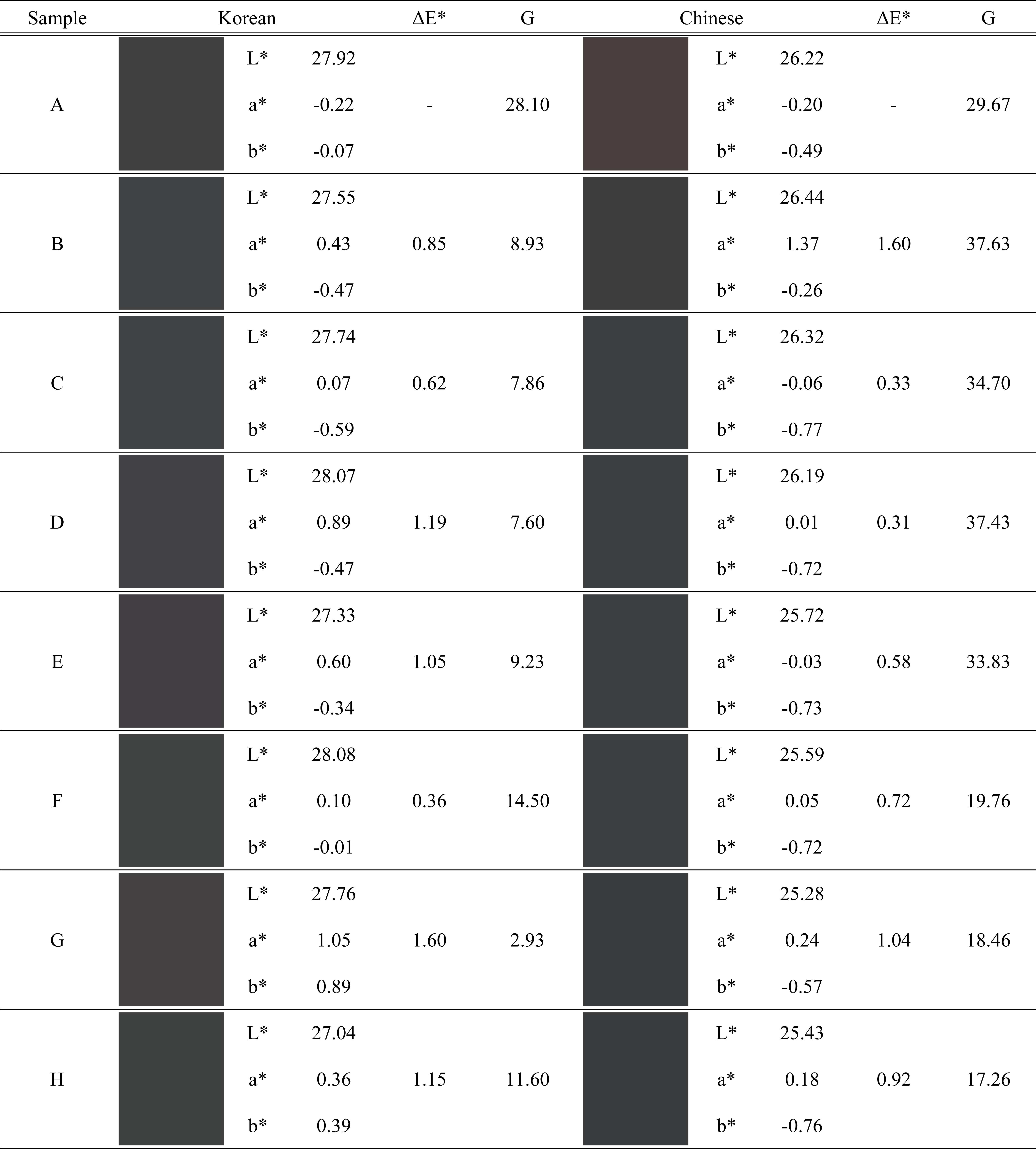
|
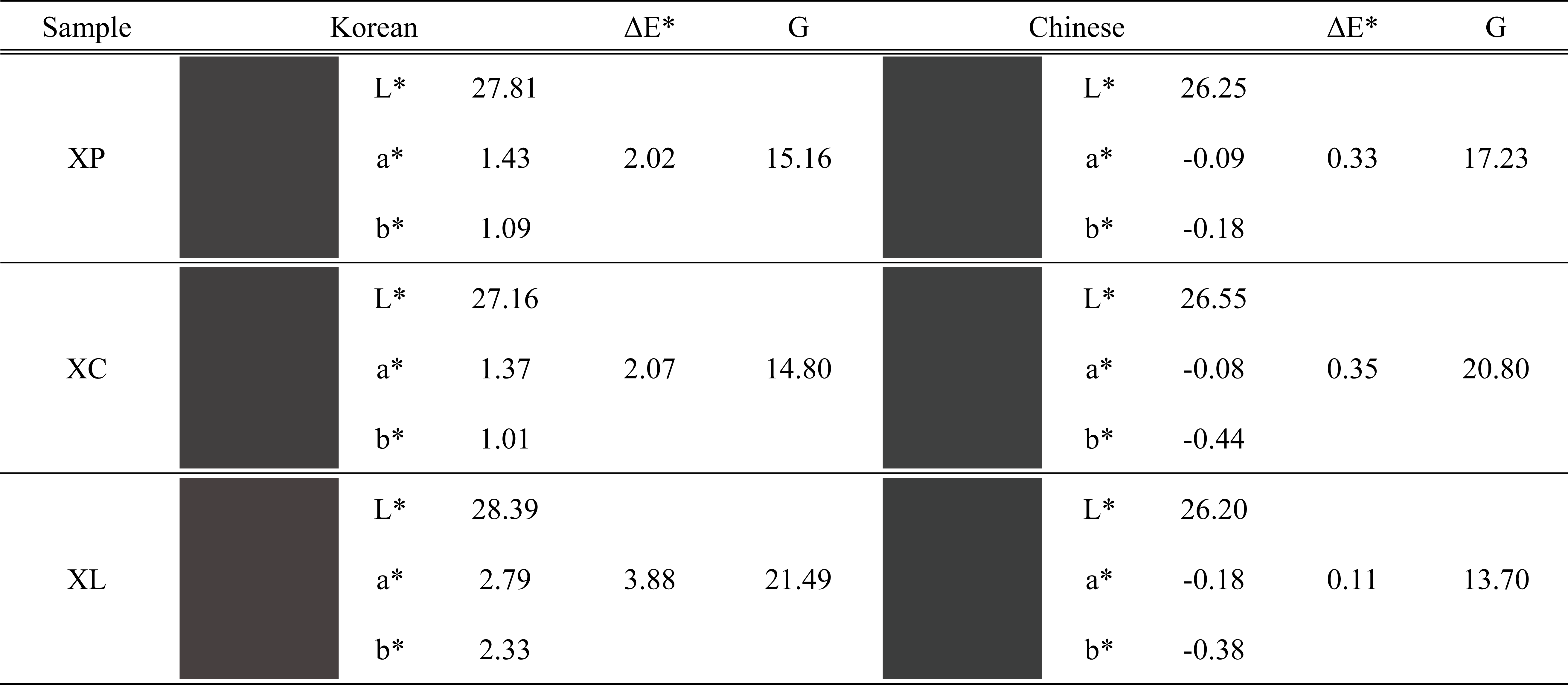
|
In the case of second coatings, the gloss of all the specimens with the laccase of the lacquer and whiterot fungi applied was lower than that of the original lacquer. In addition, it was revealed that the higher content ratio of laccase results in the smaller gloss. It was assumed that as the drying rate of lacquer improves, a rapid oxidation reaction occurs to have an interference causing the light to scatter on the lacquer surface.
Observation of the surface of the dried lacquer specimen showed that lacquer was more evenly applied, and as the number of applications increased, the solid color of the lacquer was observed instead of the wood color of the specimen.
As the laccase content ratio increased in both Korean and Chinese lacquer specimens with laccase of lacquer applied, fine cracks were observed on surfaces just as in G and H (Table 7). As the number of applications was increased, wrinkles such as rumpling on the surface of the lacquer were observed on the specimens with laccase of white-rot fungi applied (Table 8).
The thickness of lacquer layers was 30-40 μm for each layer, which suggests that relatively similar amounts were applied for each application. However, as the content ratio of laccase increased, It is estimated that when the laccase of white-rot fungi was added in the process of hardening last layer, drying time got relatively longer than when laccase of the lacquer was added, and resulting in fine cracks or wrinkles. A further study is needed on this aspect.
In case of initial coating, patterns of lacquer smudged into the wood and layers being formed on top were confirmed in both specimens with laccase of lacquer and white-rot fungi. The observations revealed that the thickness of the layers in the Korean lacquer at approximately 25 μm to 45 μm for first layer, approximately 20 μm to 40 μm of second layer, and approximately 25 μm to 45 μm of third layer. Considering that the layers were achieved in conforming to the number of applications, it could be assumed that hardening drying was formed in all the specimens with laccase applied.
However, as the content ratio of laccase to urushiol increased, fine cracks were observed on the layers of cross section, as can be seen in Korean and Chinese E ~ H (Table 9). It is presumed that as drying speed is rapidly increased, the layer-forming process is affected by the difference in shrinkage rate on the lacquer in initial drying stage.
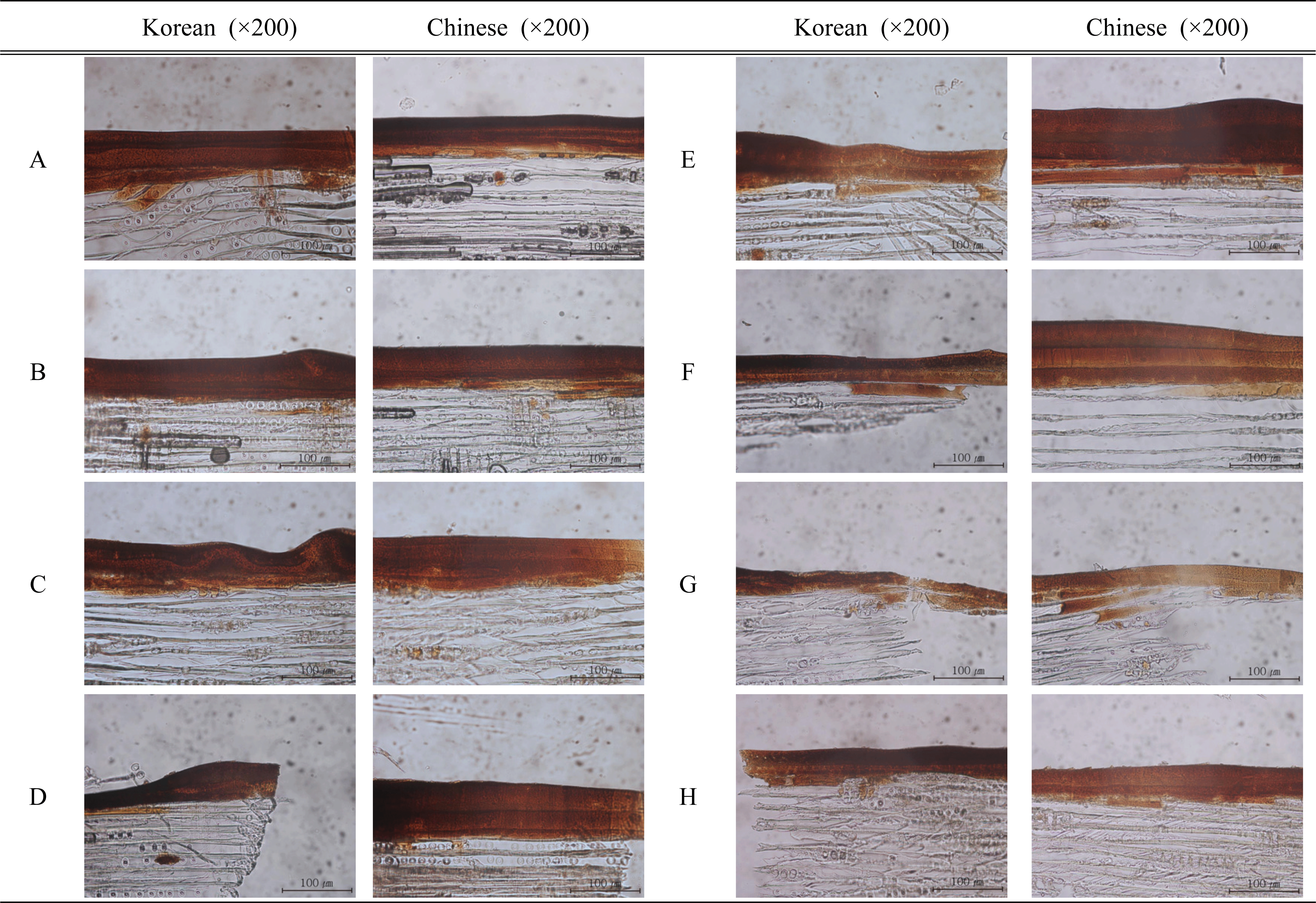
|
Both specimens with laccase of lacquer and laccase of white-rot fungi applied were confirmed to have peeling off rates of less than 0.5%, since all the surfaces were adhered except for the fine peeling by the scalpel (Table 10). In addition, since the changes in adhesion of lacquer based on the laccase content ratio were not observed, all adhesions of specimens were determined to be stable after hardening drying of the specimens.
The similar peaks of spectra had been observed from both Korean and Chinese lacquers, and specific peaks found on original lacquers were observed in the FT-IR spectra of all specimens (Park et al., 2017; Yeon et al., 2019).
As a result of analyzing the magnified fingerprint region of 1,500 cm-1 or less, there was a difference in absorbance observed in the 1,270 to 1,190 cm-1 region where a C-O stretching vibration peak appeared depending on the ratio of laccase addition (Fig. 3). When the laccase of white-rot fungi was applied at proportion of 5:1, there was a difference in absorbance observed in the same region for both Korean and Chinese spectra, and little difference between lacquers by region (Fig. 4).
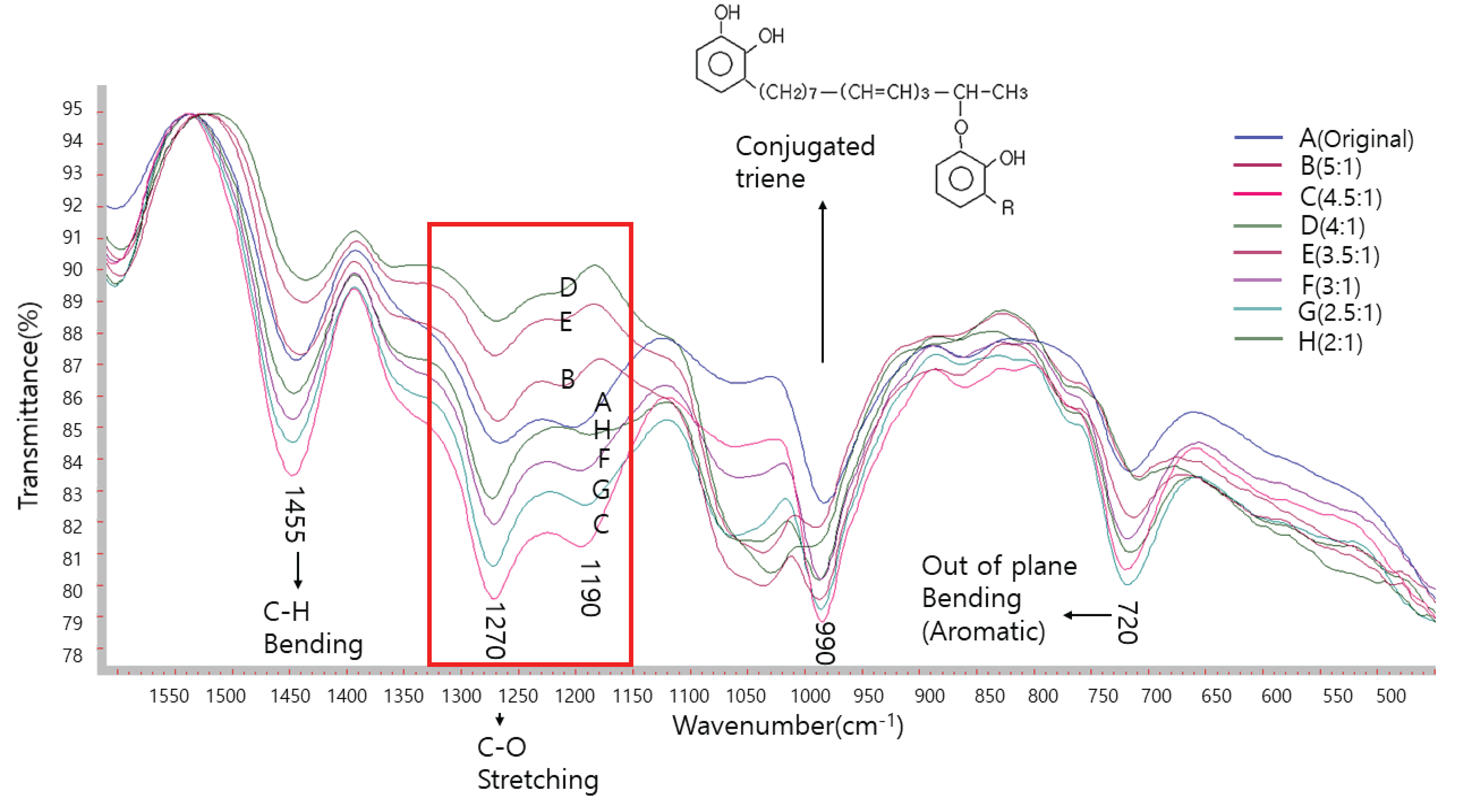
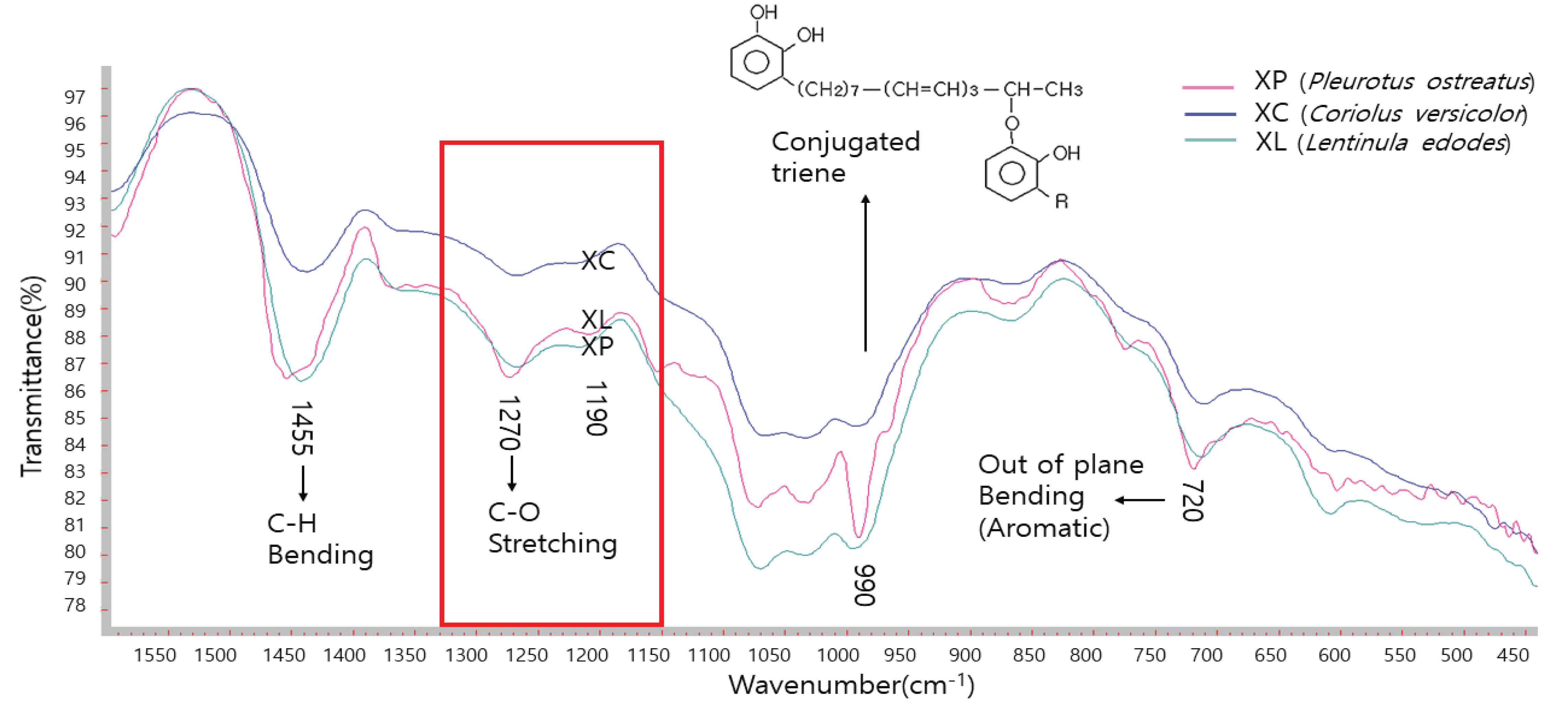
This difference seems to be emerged by the structural changes taking place in alcohol or phenol corresponding to this region as the degree of oxidation reaction changed due to the amount of laccase added. Although there were differences in intensity of the the FT-IR spectrum peaks but the peaks did not disappear, so it is consider that it doesn’t have a significant effect on physical properties.
In Korean specimens, Benzene-based compounds such as Styrene, Benzene, Propyl-, Benzealdehyde, Benzene, and butyl-, and Phenol-based compounds such as Phenol and 2-propyl- were observed. These components appear when urushiol, the main component of original lacquer, was hardened by an oxidation reaction, and biphenyl-type dimers generated during drying were also identified. In addition, undecane, dodecane, etc. coming from the alkyl chain were detected.
In Chinese specimens, benzene-based compounds such as ethylbenzene, benzene, 1,3-dimethyl-, benzene, propyl-, benzene, 1-methyl-4-propyl, and Phenolbased compounds such as phenol, 2-methyl-, phenol, 4-ethyl- were observed. In addition, components such as decane, undecane, dodecane, tetradecane, and pentadecane coming from the alkyl chain were also detected.
The components detected in the lacquer specimen following the laccase addition were mainly those that are detected in the process in which the main component urushiol is oxidized by the hardening and drying process followed by the laccase activation. No differences were observed between lacquers by each region. In addition, it is considered that even if laccase is added with 5:1 proportion of laccase to urushiol, no changes occur to the extent that it affects the properties of lacquer while acting as a catalyst for the oxidation reaction of urushiol.
4. CONCLUSION
In this study, laccases of lacquer and white-rot fungi were applied to confirm the possibility of its usage as an enzyme additive for improve the drying speed of lacquer. When laccase was applied to both Korean and Chinese lacquers, the drying time of the specimen with laccase applied was shorter than that of the specimen without laccase addition. Also all the specimens with the laccase applied were dried(set to touch) in less than 60 minutes from the start of the drying, and drying speed was improved with increase in the laccase content ratio.
In addition, although there were differences in hardening drying time between Korean and Chinese lacquers, it was confirmed that hardening drying was achieved even at room with temperature of 20 ± 2 °C and humidity of 55-60%. In contrast to original lacquer not dried in room temperature condition, when laccase added as an additive, drying rate not only improved but also expected to improve the drying conditions requiring high humidity.
As a result of lacquer layer analysis of the dried specimens, it was confirmed that the drying speed was improved when the content ratio of laccase to urushiol was 5:1, with no difference in chromaticity and adhesion, suggesting that the layers were stable. It was observed that gloss of both Korean and Chinese lacquers reduced when the lacquer was applied. However, according to the results of FT-IR and Py-GC/MS analysis, the changes in components were not as sufficient to affect the physical properties, suggesting that it can be applied as an additive. Thus, the results of this study suggest that the accessibility of laccase as an additive was confirmed and using lacquer for the conservation of lacquerware cultural properties could be increased, and an authentic conservation could be achieved.

